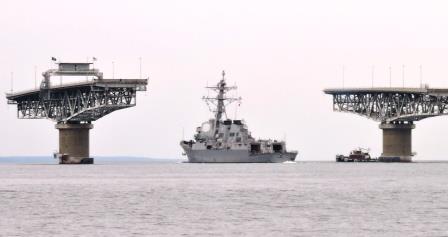A wonderful young couple from Ohio wasn’t sure whether they should choose the Adventure Cruise or the History Cruise on their three-day trip to Williamsburg. As it happened, they got both. It was also the last call of the season.
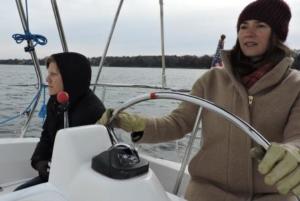 Steven Sutters and Casey Carmell work in Columbus, where he’s a software designer for a health care start-up and she’s a graphic designer for an ad agency. We got to talking about search engine optimization, in which small businesses like mine struggle to find the right mix of key words that will pop up in a google search. Casey offered “ship,” “captain” and other key words, but we agreed that “sailing” is probably sufficient. They found me on Trip Advisor and liked my web design, which was quite a compliment.
Steven Sutters and Casey Carmell work in Columbus, where he’s a software designer for a health care start-up and she’s a graphic designer for an ad agency. We got to talking about search engine optimization, in which small businesses like mine struggle to find the right mix of key words that will pop up in a google search. Casey offered “ship,” “captain” and other key words, but we agreed that “sailing” is probably sufficient. They found me on Trip Advisor and liked my web design, which was quite a compliment.
Steven’s company crunches Big Data available in the public domain to offer health care providers such as insurance companies and hospitals vital trends that might affect their premiums and medical research. It sounded very cutting-edge. Neither of them thought the Republicans will repeal the Affordable Health Care Act, but rather modify it around the edges.
Excellent questions
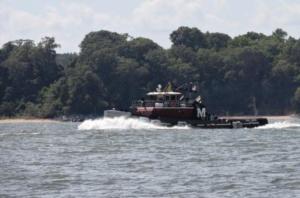 They asked excellent questions about the Battle of the Capes and Siege at Yorktown. I lamented that so many people come to Williamsburg without engaging in the history. It’s distressing that they have no curiosity about the past.
They asked excellent questions about the Battle of the Capes and Siege at Yorktown. I lamented that so many people come to Williamsburg without engaging in the history. It’s distressing that they have no curiosity about the past.
Off in the distance as we headed downriver I could see two large Moran tugboats lumbering toward us. It was Monday, so that meant they were leading a US Navy warship into the river where they would receive it at Yorktown Naval Weapons Station. As they passed by we could see the distinctive conning tower of a Navy destroyer. It got to the top of the channel and turned to port to head inland.
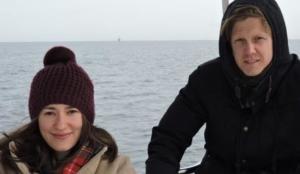
We were out downriver where I could show Big Island and Goodwin Island as the two point between which the French moored four warships in 1781 to block Lord Earl Cornwallis from exiting Yorktown. I radioed the bridge of the warship to report our position. The ship was directly behind us three miles away. I told the bridge I was already on the south side of the river and would let him pass on my starboard, with plenty of leeway if I hugged the coast. He agreed. You can see the ship between Casey and Steven. She yielded the helm to me so I could take control as the ship neared.
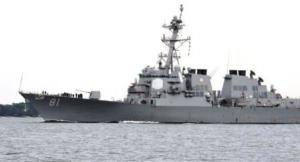 As it neared, Steven googled “Warship 81,” the radio code we picked up when I contacted the bridge earlier. It was the USS Winston S. Churchill, a 1990s destroyer whose distinction is that it has a Royal Navy officer on board as permanent party (usually as a navigator).
As it neared, Steven googled “Warship 81,” the radio code we picked up when I contacted the bridge earlier. It was the USS Winston S. Churchill, a 1990s destroyer whose distinction is that it has a Royal Navy officer on board as permanent party (usually as a navigator).
Boat too close to ship
Inexplicably, a sport fishing boat was proceeding across the river into the path of the ship. The fishing boat turned as if to get closer and was within a half-mile, off the bow. The Churchill radioed the guy to move, but he didn’t respond. The ship radioed that it was slowing to avoid a collision. We could see it because the wake off the bow quickly died down. The fishing boat moved along on the other side of the river and the ship resumed speed.
The Churchill passed by us at 10 knots and we could see sailors standing on the bow. Another distinction was that the ship had no visible wake. We began to motor to get closer to the bridge, and our wake was more prominent than the destroyer’s. Ten minutes later, we could see a faint outline of the wake and heard it wash onto shore. How did they do that?
Equally amazing, the Coleman Bridge opened sideways to let the ship transit. One of the two Moran tugs was there to receive it and help snug into the dock. The tug eventually returned to Norfolk, but there was no sign of the other tug. Only silence on a grey afternoon as we sailed more tacks across the river.
Let’s go sail
Check rates and pick a day for a sailboat charter. See reviews on Trip Advisor from sailors like you.
